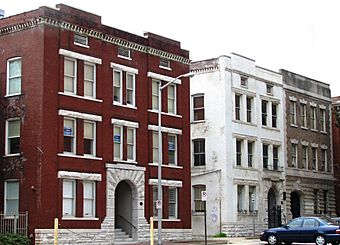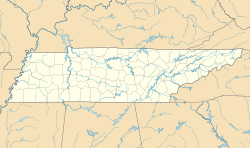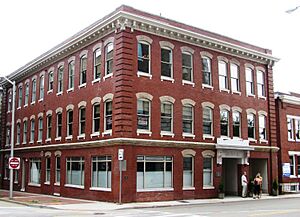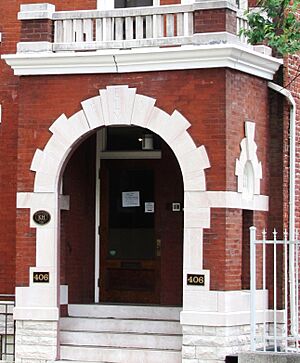South Market Historic District facts for kids
Quick facts for kids |
|
|
South Market Historic District
|
|

713, 709, and 707 Market Street
|
|
| Location | 707, 709, and 713 Market St. and 404 and 406 Church Ave. Knoxville, Tennessee |
|---|---|
| Area | 1.5 acres (0.61 ha) |
| Built | circa 1895–1907 |
| Architectural style | Italianate, Renaissance Revival |
| NRHP reference No. | 96001403 |
| Added to NRHP | December 4, 1996 |
The South Market Historic District is a group of five old buildings in Knoxville, Tennessee. These buildings are located where Market Street and Church Avenue meet. They were added to the National Register of Historic Places in 1996 because of their history.
The buildings include the Cherokee Building, the Ely Building, the Cunningham, the Stuart, and the Cate. They were built between about 1895 and 1907. These buildings were used for both offices and homes. Many important doctors and marble companies had their businesses here in the early 1900s.
Where is the South Market Historic District?
The five buildings of the South Market Historic District are on the southwest corner of Market and Church streets. The Cherokee and Ely buildings face Church Avenue. The other three buildings face Market Street.
A very tall, 15-story building called the General Building stands across the street. There is also a patio and courtyard area behind the Cherokee, Ely, and Cunningham buildings. You can reach this area through small walkways. The red brick sidewalk in front of the buildings was built in 1982. This was part of city improvements for the 1982 World's Fair.
History of the Buildings
The land where these buildings stand was part of Knoxville's first city map from 1791. Market Street was once called Chestnut Street, then Prince Street. It was a very important street for businesses. This was because it led to the Prince Street Wharf on the Tennessee River. In the 1850s, Prince Street was one of Knoxville's first paved roads.
By the time of the American Civil War, most of Knoxville's business had moved to other areas. South Market became more of a neighborhood with homes. An 1886 map shows smaller buildings here. A church also stood where the tall General Building is now.
In the 1890s, Knoxville became more crowded. Large single-family homes in the downtown area started to disappear. Builders began to prefer smaller buildings that could be used for both homes and businesses. Many buildings in the South Market Historic District show this change. Their first floors were for offices, and the upper floors were for homes.
Many important people had offices in these buildings. This included doctors like J. M. Kennedy and C. E. Ristine. Three marble companies worked out of the Stuart Building in the early 1900s. Coal and mining companies also had offices in the Cunningham Building. Around 1910, the Knoxville Business College moved into the Cherokee Building. By 1931, many different businesses were in the Cherokee Building. These included real estate companies, notaries, an eye doctor, and even a laundry service.
Meet the Buildings
Here are the five buildings that make up the South Market Historic District:
- The Cherokee Building (404 Church Avenue) is a three-story brick building. It was built around 1895 and has an Italianate style. It used to have more entrances, but they are now windows. This building has been home to many businesses. Today, it has apartments and law offices.
- The Ely Building (406 Church Avenue) is a two-story brick building. It was built in 1903 for doctors' offices and also has Italianate features. It has a special arched entrance with marble steps. There is also a stairway that goes down to a basement entrance.
- The Cunningham Building (707 Market Street) was once called the "Keystone Building." It is a three-story brick building built in late 1907. It has a Renaissance Revival style. You can see its marble trim and a special arched entrance. Today, it has law offices on the first floor and apartments above. In the past, it housed doctors, mining companies, and even a boating association.
- The Stuart Building (709 Market Street) was first known as the "McNutt Building." It is a three-story brick building from 1902. It also has a Renaissance Revival style. It features limestone trim and marble steps. Today, it is home to several law offices.
- The Cate Building (713 Market Street) is another three-story brick building. It was built around 1895 and has a Renaissance Revival style. Like the Stuart, it was also once called the "McNutt Building." It has limestone trim and marble steps. This building also houses law offices today.





